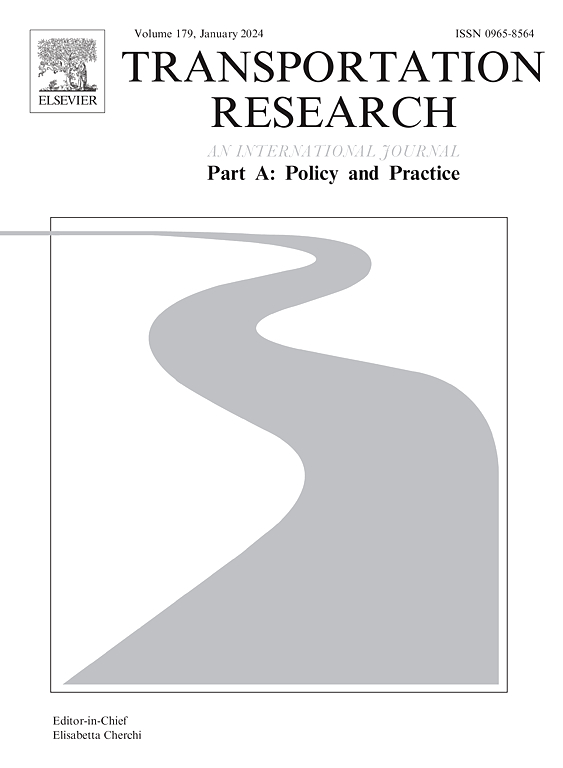Perceived accessibility and self-rated health: Examining subjective well-being in the suburbs of Scarborough, Canada
IF 6.8
1区 工程技术
Q1 ECONOMICS
Transportation Research Part A-Policy and Practice
Pub Date : 2024-09-27
DOI:10.1016/j.tra.2024.104261
引用次数: 0
Abstract
Addressing inadequate accessibility in suburban areas is crucial for reducing inequalities in transportation and improving suburbanites’ well-being. Afterall, insufficient accessibility to health is linked to worse health conditions. Moreover, urban sprawl, subpar transit, and automobile dependency prevail in suburbs, making them loci of inequalities in accessibility and, consequently, of potential worse health outcomes for residents. Due to their predictive capacity, subjective health indicators have been extensively researched. Knowledge on Self-Rated Health’s (SRH) link to accessibility in suburbs, however, is incomplete because the field seldom considers individuals’ perceptions. This article examines the association between accessibility and SRH in suburban areas. Using ordinal logistic regressions and data from a survey in Scarborough, Canada, we investigate if accessibility measures estimated from land-use and transportation network data (estimated measures), perceived accessibility, and perceptions of the built environment are associated with SRH. We explore these connections with different domains of SRH (mental, physical and overall). We find that living in areas with higher estimated accessibility measures is positively correlated with better SRH, whereas unsatisfactory perceived accessibility is negatively associated. Additionally, suburbanites who prioritize access to healthcare nearby have lower odds of having better health, meaning that residents who would like to see healthcare access improve are more likely to have worst SRH. Estimated measures are positively associated with self-rated mental health, while reporting difficulty in paying for transport is negatively associated with physical health. These findings stress how multiple components of accessibility – from estimated to perceived measures– can be associated with people’s well-being. Results illuminate the relevance of considering perceptions, often overlooked, in accessibility and health analysis. Finally, the results put into question if suburbanites’ heterogenous needs are recognized in urban design in a context of recent suburbanization of poverty.
感知的可达性与自我健康评价:考察加拿大士嘉堡郊区的主观幸福感
解决郊区交通不便的问题对于减少交通不平等和改善郊区居民的福祉至关重要。毕竟,交通不便与健康状况恶化息息相关。此外,郊区普遍存在城市无计划扩展、交通不便和对汽车的依赖等问题,这使得郊区成为交通不便的不平等地区,从而可能导致居民的健康状况恶化。由于主观健康指标具有预测能力,因此对其进行了广泛的研究。然而,关于自评健康(SRH)与郊区交通便利性之间联系的知识还不完整,因为该领域很少考虑个人的看法。本文研究了郊区交通便利性与 SRH 之间的关系。通过使用顺序逻辑回归和加拿大士嘉堡的调查数据,我们研究了根据土地使用和交通网络数据估算的可达性指标(估算指标)、可感知的可达性以及对建筑环境的感知是否与性健康和生殖健康相关。我们探讨了这些与性健康和生殖健康不同领域(精神、身体和整体)的联系。我们发现,居住在估计无障碍程度较高的地区与更好的性健康和生殖健康呈正相关,而感知无障碍程度不理想则呈负相关。此外,优先考虑就近获得医疗保健服务的郊区居民健康状况较好的几率较低,这意味着希望医疗保健服务得到改善的居民更有可能拥有最差的性健康和生殖健康状况。估算措施与自评心理健康呈正相关,而报告交通支付困难与身体健康呈负相关。这些发现强调了可及性的多个组成部分--从估计到感知测量--如何与人们的福祉相关联。研究结果表明,在进行交通便利性与健康分析时,考虑人们的感知是非常重要的,而人们的感知往往被忽视。最后,研究结果还提出了一个问题:在近年贫困郊区化的背景下,郊区居民的不同需求是否在城市设计中得到了认可。
本文章由计算机程序翻译,如有差异,请以英文原文为准。
求助全文
约1分钟内获得全文
求助全文
来源期刊
CiteScore
13.20
自引率
7.80%
发文量
257
审稿时长
9.8 months
期刊介绍:
Transportation Research: Part A contains papers of general interest in all passenger and freight transportation modes: policy analysis, formulation and evaluation; planning; interaction with the political, socioeconomic and physical environment; design, management and evaluation of transportation systems. Topics are approached from any discipline or perspective: economics, engineering, sociology, psychology, etc. Case studies, survey and expository papers are included, as are articles which contribute to unification of the field, or to an understanding of the comparative aspects of different systems. Papers which assess the scope for technological innovation within a social or political framework are also published. The journal is international, and places equal emphasis on the problems of industrialized and non-industrialized regions.
Part A''s aims and scope are complementary to Transportation Research Part B: Methodological, Part C: Emerging Technologies and Part D: Transport and Environment. Part E: Logistics and Transportation Review. Part F: Traffic Psychology and Behaviour. The complete set forms the most cohesive and comprehensive reference of current research in transportation science.

 求助内容:
求助内容: 应助结果提醒方式:
应助结果提醒方式:


